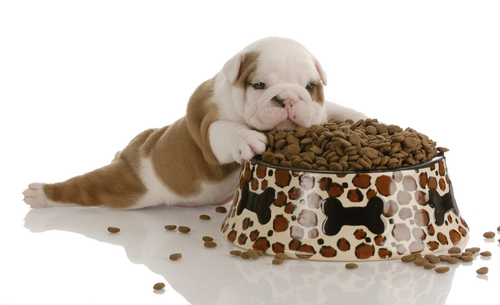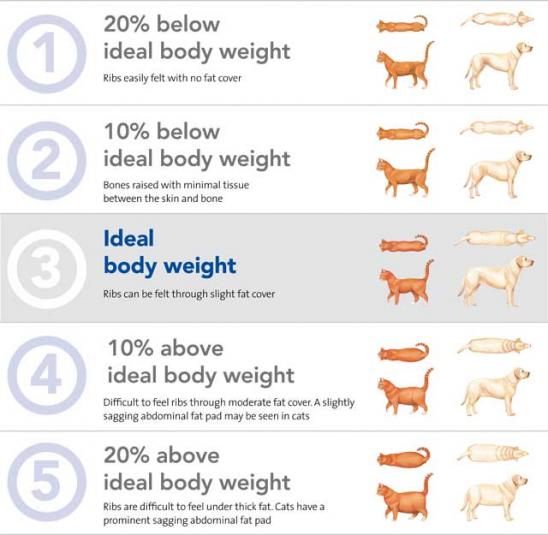
Food is love… right? However, it is possible to kill your pet with kindness. Over 50% of pets in the United States are overweight. Losing weight can add years to your pet’s life – and it can also make those years much more enjoyable for them.
Is my pet overweight?
Honestly, the best way to tell is by petting your dog or cat – something you probably do multiple times a day.
A pet that is in ideal body condition should have very minimal fat. The first place excess fat starts to accumulate is over the ribs. Ideally you should feel over their ribcage and just feel their skin and their ribs. If you have to apply pressure with your fingers to feel them or cannot feel them at all that means they have a significant fat layer between the skin and the underlying muscle and bones – this means your pet is overweight to obese. Pets should also have a natural waistline – when you look from above and from the side. Refer to the charts below to evaluate where your pet is.

The health consequences
Did you know that if your pet is just 5 pounds overweight, they are at risk for serious medical conditions, some of which are life threatening? Overweight pets are prone to developing:
Diabetes
Arthritis and joint disease (as their bones and joints have to bear so much more weight)
Heart disease
Increased risk for heat stroke
High blood pressure
The formula for weight loss is simple. Fewer calories in + increased exercise/activity = weight loss.
Reducing Calories
Limiting treats
If your pet is overweight, ideally we would eliminate treats from their diet altogether. If you still want to give your pet treats you can replace the treats with healthier, lower calorie alternatives – for example, vegetables (such as carrots). Another option is giving them their regular dry dog food as treats (subtracting this from the total amount you’re feeding at meal times).
Be sure to set aside the total amount of treats that your pet can get for the day in a separate container – this is especially important for when there are multiple people in the household – once it’s empty, no more treats can be given that day
Reducing portions
Start with a 25% reduction in how much you’re feeding currently
You can also ask your veterinarian to calculate your pet’s daily energy requirement so you know exactly how many calories you should be feeding
Place them on a prescription diet/weight loss food (with your veterinarian’s recommendation)
Often these diets are low in calories and high in fiber – which help pets to feel more full
Burning Calories
What is the ideal amount of exercise? Aim for at least 30 minutes of activity per day – it’s okay to divide this into multiple sessions throughout the day.
The pace at which we walk most of our dogs, stopping every few minutes to allow them to sniff or pee on a bush, is not conducive to burning calories. Running is great exercise, but even a brisk walk (at a pace that has you breaking a light sweat after the first few minutes) is good
If you work a regular 9-5 job, consider hiring a dog walker to stop by mid-day or bringing your dog to doggy day care (where they spend a lot of time running and playing with other dogs)
Other simple things you can do around the house are:
Placing their food into a food dispensing toy/treat puzzle - it will force them to eat slower and also provides a mental challenge since they have to work for their meal – mental exercise is also helpful for their overall well-being
Moving their food bowl around the house (alternating upstairs/downstairs)
Toys, balls or squeaky toys to encourage games of chase or fetch
Be mindful that with outdoor exercise, overweight or older dogs may be at increased risk for heat stroke – for these dogs, the best time for exercise is early in the morning or late in the evening when temperatures cool down. If your dog has joint problems, then swimming is a great alternative.
If all of the above has been tried and your pet is still not losing weight (or worse, gaining weight in the face of it all), then they may have an underlying medical condition – the two most common for dogs are hypothyroidism and Cushing’s disease.
Track Progress
It’s extremely important that once you start pursuing a weight loss plan that you track your pet’s progress. You can do this by bringing your pet in to BRVC and using our scale to weigh them – after you do this, you can stop by the front desk and a receptionist can enter your pet’s new weight into our computer system so we can track their weight month by month! We can even email you or print out a special graph that charts your pet’s weight.
If a trip to the vet is too far out of the way for you, you can also weigh your pet at home – either by holding them in your arms while you step onto the scale (and then subtracting your weight from that number) or purchasing a scale for them – this is more important for small dogs and cats, where often weight loss is fractions of a pound rather than multiple pounds at a time. The same scale should be used consistently.
It is important to know that if you pet is not losing weight on their current weight loss plan we need to continue to make adjustments to either the amount they’re being fed or the amount of exercise they’re getting. Each pet is an individual – you and your veterinarian need to work together to tailor a weight loss plan that is unique to your pet.
Tags: ask the vet, pet obesity, overweight, Stefanie Wong







